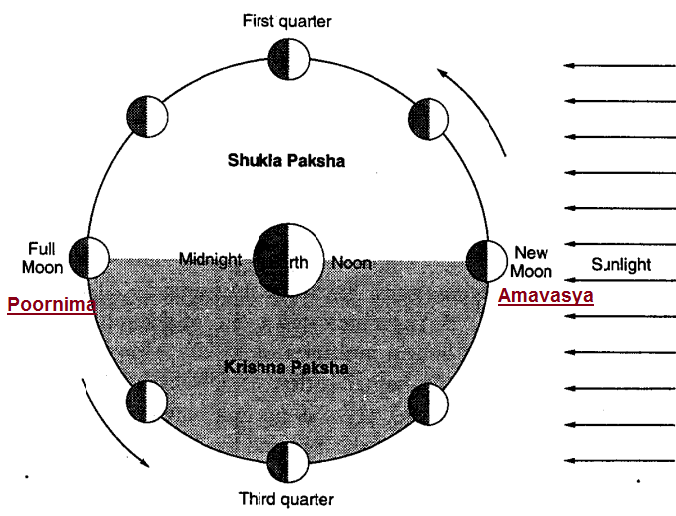Moon in Vedic Astrology
She has a corpulent body (fat body), young as well as old, curly hair, white in complexion, has lovely eyes. The Moon is the ruler of the mind and intelligence, mental disposition, heart, mother, beauty, saturation of blood, renowned persons, young Women, fond of walking, soft in speech, magnetic force, scent, juice, fickle-minded and very lustful. Watery substances, lakes, sea, temple of Goddess Durga, vegetation, rain, textile, chemicals( fine chemicals and pharmaceuticals), alcohol, milk, honey, sugarcane, pearls, sweet things, rice, barely, wheat and agriculturists.
Parts of Body
The organs of the body ruled by her are the arteries, nerves, brain, fat, stomach, uterus, bladder, breast, ovaries and organs of procreation.
Diseases
Diseases that are caused by her are venereal diseases, jaundice, dyspepsia, asthma, bronchitis, skin diseases etc. She is phlegmatic and windy.
Caste : Vaishya
Direction :Northwest
Sex : Feminine
The moon is related to mind and hence described as the Matrukaraka and Manakaraka (significator) of mind and mother. All queries about the mind and mother can be predicted from the position of the moon in the horoscope. A powerful moon gives favourable results whereas a weak moon offers bad results in the spheres signified by moon viz. Conception, delivery, life before adulthood, change of occupation, tendency to change every thing every now and then, stomach, breast, beauty, digestive power, blood, milk, gems, etc., In the royal family of planets moon is given the position of the queen. Among the Rasis the moon is the Lord of Cancer.
A solar day starts from sunrise and extends to the next sunrise on the following day. A lunar day, known as the Thithi is calculated from the longitudinal distance between the sun and the moon. There are thirty thithis in a lunar month distributed over 360° of the zodiac. Therefore, each thithi has a span of 12″. The first thithi commences from the point of conjunction of the sun and the moon (on new moon day) and extends till the moon moves 12″ away from the sun. The second day begins when the distance between the sun and the moon is 12° and extends till the moon is 24° from the sun. There are 14 thithis in each half of the month-the Sukla Paksha and the Krishna Paksha – and the other two days are the Full Moon day, which is the 15th day and the New Moon day which is the 30th or the last day of the month

One can calculate the thithi by dividing the longitudinal distance between the Sun and the Moon by 12.
For example, suppose the moon’s position is in the 2nd Rasi, Vrishabha at 10° 34’ and the sun is in the 3rd Rasi, Mithuna, at 3° 14′, the difference would be (13-10)-34)-(2-3-14)=11-7-20 or 337 degrees 20 minutes. (If the moon’s Rasi is less then the sun’s, 12 Rasis should be added to the moon’s). By dividing 337° 20’ by 12, we get 28 as the quotient and 1° 20’ as the Remainder. The thithi is the early portion of the 29th, which is Krishna Paksha Chaturdashi.
General Significations of Moon
Mother, comforts to and from mother, beauty, facial luster, gracefulness, fame, happiness, vehicles, mind, mental capabilities, intelligence, sense of humor, woman’s inclination, mental agility, nature of an individual, contentment, laziness, sleep, liquids, water, milk, curd, honey, saline, eating, delicious fruits, fish and aquatic animals, snakes and other reptiles, flowers, perfumes, blossoms, fine clothes, white colour, crystals, silver, bronze, pearls, royal insignia, well, tank, lake, expanses of water, pilgrimage, pleasures, splendour, shyness, modesty, mildness, kindness, love, lover, affection, royal favour, wheat, white rice, sugarcane, salt, Brahmins, north-west direction, rainy season (Varsha), a muhurta. (a time period equivalent to 48 minutes), middle age, world of the Manes.
In Medical Astrology
Mental illness, epilepsy, ulcers, acidity, phlegmatic disorders, pleurisy, tuberculosis, blood disorders, breast, left eye, malarial fever, fevers associated with chills and rigors, sleep disorders, menstrual problems, disease of shoulders, fear from watery animals.